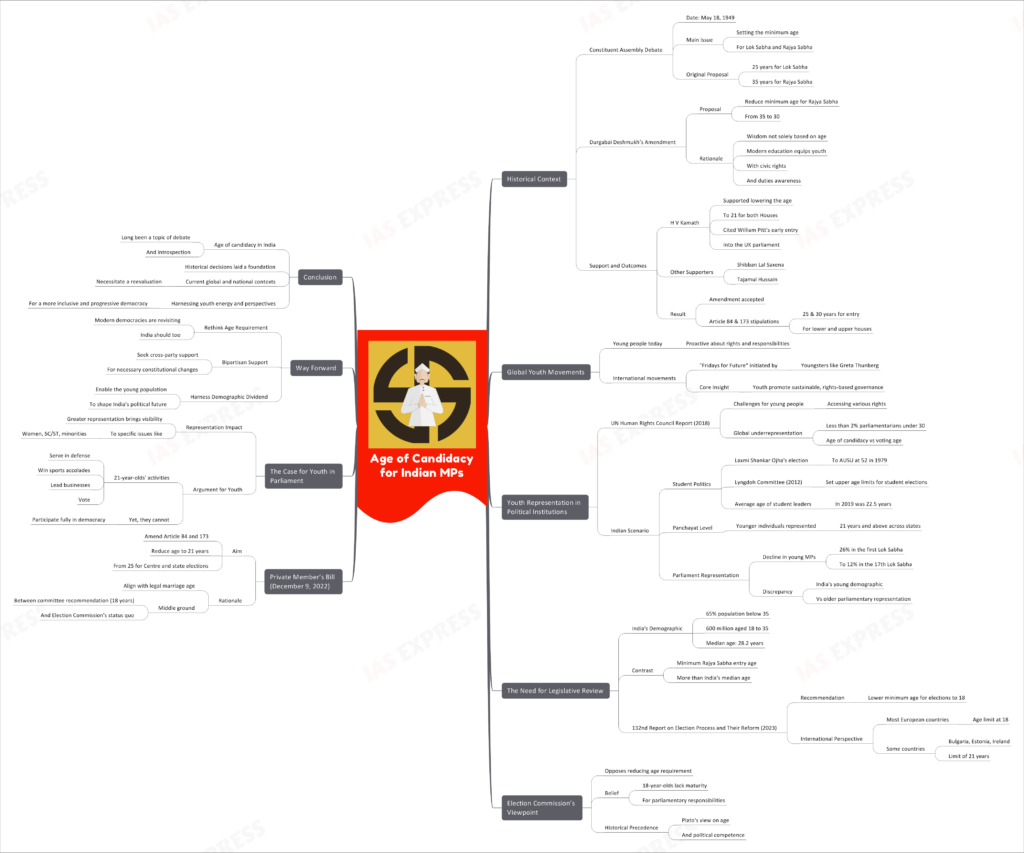Age of Candidacy- The Case for Reducing Minimum Age for Indian MPs

The debate on setting an appropriate age for parliamentary candidacy in India dates back to the time of the Constituent Assembly.

This topic of “Age of Candidacy- The Case for Reducing Minimum Age for Indian MPs” is important from the perspective of the UPSC IAS Examination, which falls under General Studies Portion.
Historical Context
Constituent Assembly Debate
- Date: May 18, 1949.
- Main Issue: Setting the minimum age for entering Lok Sabha and Rajya Sabha.
- Original Proposal:
- 25 years for Lok Sabha.
- 35 years for Rajya Sabha.
Durgabai Deshmukh’s Amendment
- Proposal: Reduce the minimum age to enter Rajya Sabha from 35 to 30.
- Rationale:
- Wisdom does not depend solely on age.
- Modern education equips youth with civic rights and duties awareness.
Support and Outcomes
- H V Kamath:
- Supported lowering the age uniformly to 21 for both Houses.
- Cited William Pitt’s early entry into the UK parliament as evidence.
- Other Supporters: Shibban Lal Saxena, Tajamul Hussain.
- Result: Amendment accepted. Article 84 & 173 now stipulate 25 & 30 years as entry ages for lower and upper houses respectively.
Global Youth Movements
- Young people today are proactive about their rights and responsibilities.
- International movements such as “Fridays for Future” initiated by youngsters like Greta Thunberg at 15.
- Core Insight: Youth are active agents in promoting sustainable, rights-based governance globally.
Youth Representation in Political Institutions
UN Human Rights Council Report (2018)
- Identified challenges for young people in accessing various rights.
- Global underrepresentation of youth in politics:
- Less than 2% parliamentarians under 30.
- Age of candidacy often not aligned with voting age.
Indian Scenario
- Student Politics:
- Laxmi Shankar Ojha elected to AUSU at 52 in 1979.
- Lyngdoh Committee (2012) set upper age limits for student union elections.
- Average age of student leaders in 2019 was 22.5 years.
- Panchayat Level: Younger individuals (21 years and above) finding representation across states.
- Parliament Representation:
- Decline in young MPs (25-40 years): 26% in the first Lok Sabha to 12% in the 17th Lok Sabha.
- Discrepancy: India’s young demographic vs. older parliamentary representation.
The Need for Legislative Review
- India’s Demographic:
- 65% population below 35.
- 600 million aged between 18 to 35.
- Median age: 28.2 years.
- Contrast: Minimum Rajya Sabha entry age (30 years) is more than India’s median age.
132nd Report on Election Process and Their Reform (2023)
- Recommendation: Lower the minimum age for elections to 18 years.
- International Perspective:
- Most European countries set age limit at 18.
- Some like Bulgaria, Estonia, Ireland, etc. have a limit of 21 years.
Election Commission’s Viewpoint
- Opposes reducing the age requirement.
- Belief: 18-year-olds lack the maturity for parliamentary responsibilities.
- Historical Precedence: Plato’s view on age and political competence.
Private Member’s Bill (December 9, 2022)
- Aim: Amend Article 84 and 173 to reduce minimum age to 21 years from 25 for Centre and state elections.
- Rationale:
- Align with legal marriage age.
- Middle ground between committee recommendation (18 years) and Election Commission’s status quo.
The Case for Youth in Parliament
- Representation Impact: Greater representation brings visibility to specific issues.
- Women, SC/ST, minorities have changed discussions with representation.
- Argument for Youth:
- 21-year-olds serve in defense, win sports accolades, lead businesses, and vote.
- Yet, they cannot participate fully in democracy as candidates.
Way Forward
- Rethink Age Requirement: Modern democracies worldwide are revisiting age requirements, and India should too.
- Bipartisan Support: Seek cross-party support for necessary constitutional changes.
- Harness Demographic Dividend: Enable the massive young population to shape India’s political future.
Conclusion
The age of candidacy in India has long been a topic of debate and introspection. While historical decisions laid a foundation, current global and national contexts necessitate a reevaluation. As India stands on the cusp of demographic potential, it’s crucial to harness the energy, aspirations, and perspectives of its youth for a more inclusive, progressive, and representative democracy.
Practice Question for Mains
Comment on the age criteria for MPs in India. Examine the case for reducing the age of candidacy. (250 words)

